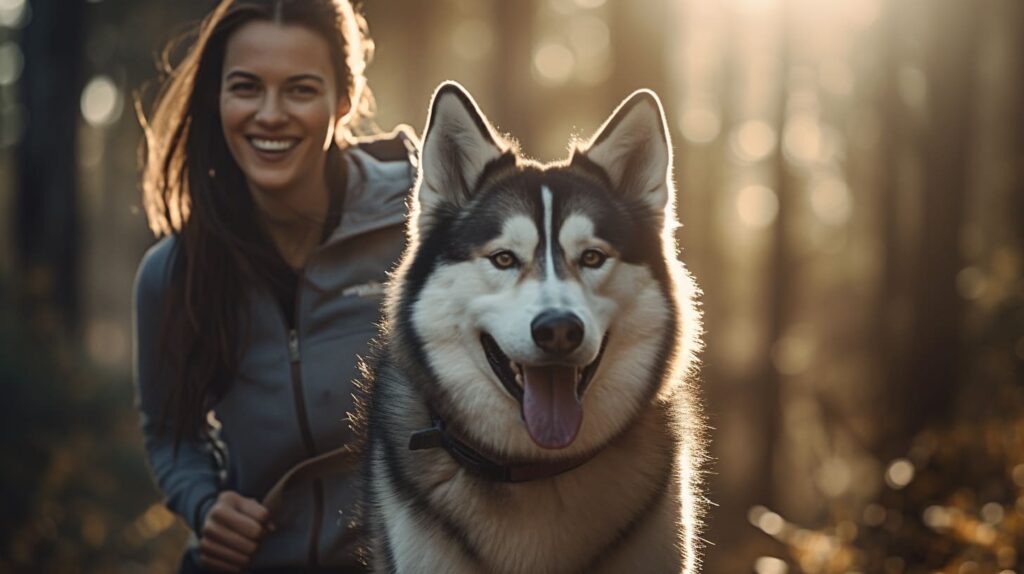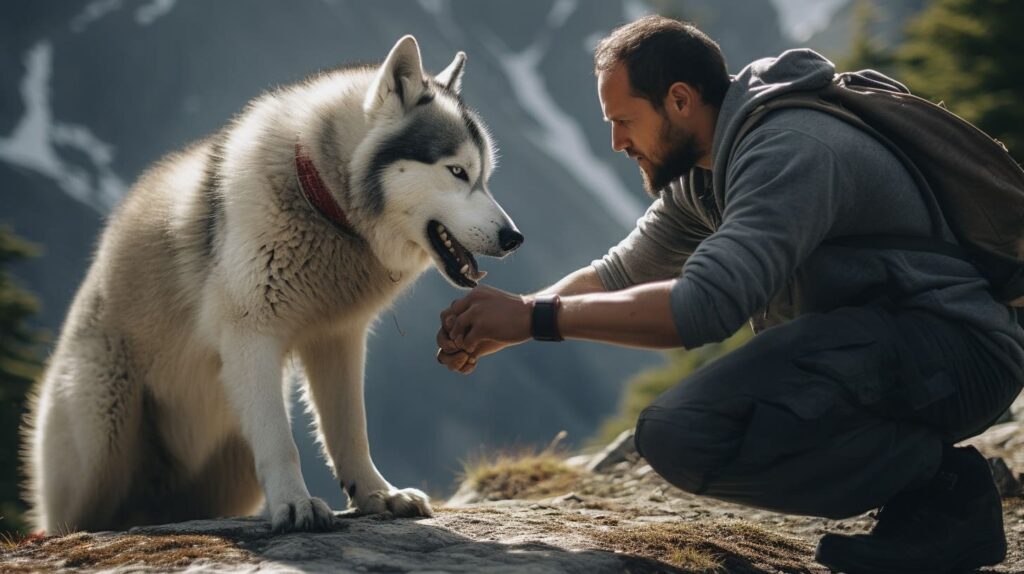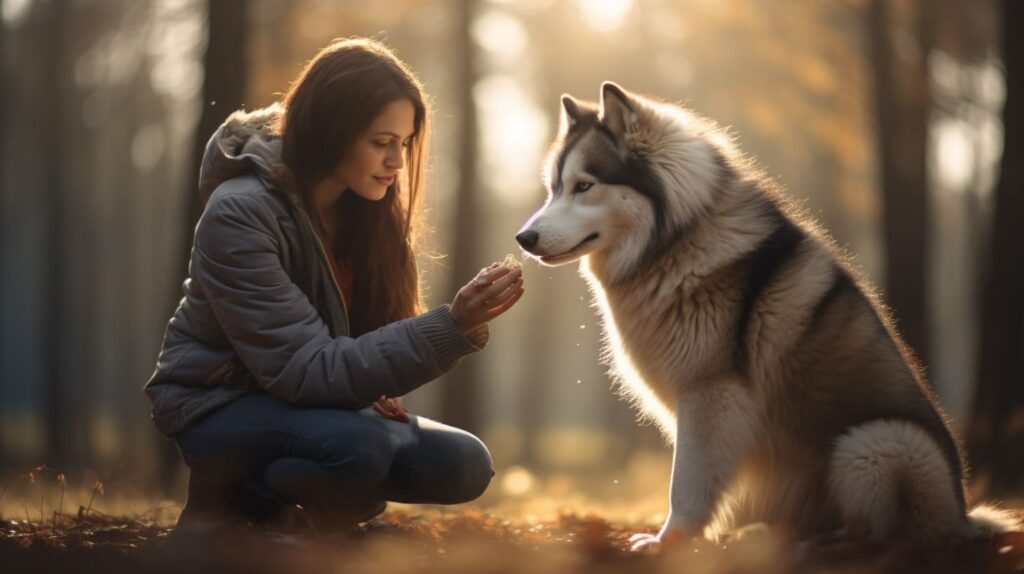Training a Husky is a venture filled with challenges and rewards. Known for their intelligence, energy, and a touch of independence, Huskies are a unique breed that requires a tailored approach to training. Originating from the cold Siberian landscapes, these dogs were bred to be diligent sled pullers, capable of covering vast icy expanses with minimal supervision. Their background not only contributes to their unique personality but also to their training needs.
This article aims to provide Husky owners with a comprehensive guide on training their furry companion. Whether you’re a first-time Husky parent or looking to improve your training skills, this guide will equip you with the knowledge needed to foster a harmonious and rewarding relationship with your Husky. From understanding their behavior to mastering basic commands and tackling advanced training techniques, we’ve got you covered. So, let’s embark on this training journey together to learn how to train a Husky ensure your companion becomes a well-behaved and joyful family member.
Table of Contents
Understanding Husky Behavior
Before diving into the training process, it’s imperative to have a grasp on Husky behavior. Understanding their temperament and traits will set the foundation for successful training sessions.
Independent Nature
Huskies are known for their independent nature, a trait that served them well in the harsh climates of Siberia where they originated. This independence can sometimes be mistaken for stubbornness during training. However, it’s just a Husky’s way of analyzing situations and making decisions independently.
Working Dog Background
Huskies are born and bred working dogs, with a strong heritage of pulling sleds in harsh conditions. This background instills in them a strong work ethic and an energetic demeanor. They thrive on challenges and enjoy tasks that engage their mind and body.
Intelligence
Huskies are incredibly intelligent dogs. They have a knack for problem-solving and can learn commands and tricks quickly. However, their intelligence also means they can easily get bored, making it crucial to keep training sessions engaging and varied.
Need for Mental Stimulation
Due to their intelligence, Huskies require a good amount of mental stimulation to keep them content. Training sessions, puzzle toys, and interactive games are excellent ways to challenge their minds and keep boredom at bay.
Early Socialization
Huskies are naturally friendly and sociable dogs. However, early socialization is essential to ensure they react well to other dogs, animals, and humans. Exposing them to various environments, sounds, and situations from a young age can lead to a well-adjusted, confident dog.
Understanding the core of Husky behavior is the first step towards effective training. By appreciating their independent nature, working dog background, intelligence, and the need for mental stimulation and socialization, you are well on your way to developing a training approach that caters to the unique needs of a Husky. This understanding is a crucial foundation upon which successful training regimes are built.
Establishing Leadership
Establishing leadership is a crucial step in training a Husky. These intelligent and independent dogs respond well to a leader they trust and respect. Let’s delve into how you can establish a leadership role that will aid in training your Husky effectively.

Being a “Pack Leader”
In the wild, dogs thrive in packs with clear hierarchical structures. Although domesticated, Huskies still have an innate understanding of this pack mentality. Being a pack leader means exuding confidence and consistency in interactions with your Husky, which in turn instills a sense of security and obedience.
- Dogs thrive in packs with clear hierarchical structures in the wild
- Huskies, even when domesticated, still have an innate understanding of pack mentality
- Being a pack leader for your Husky involves exuding confidence and consistency
- Interactions with your Husky should be firm and assertive, yet fair and consistent
- Establishing yourself as the pack leader instills a sense of security and obedience in your Husky
- Pack leaders provide guidance and direction to their Huskies, which helps maintain a harmonious and well-behaved pet.
Building Trust and Respect
Trust and respect are the cornerstones of establishing leadership. Engage in positive interactions, be consistent with rules, and ensure your Husky feels safe and cared for. This will foster a bond of trust and respect, making training sessions more productive.
Communicating Clearly
Clear communication is essential in establishing a leadership role. Use commands consistently, employ a firm but gentle tone, and utilize body language to convey your messages. Being clear and consistent in your communication will help your Husky understand what is expected of them.
Leading by Example
Dogs are excellent at reading body language and picking up on human emotions. Displaying calmness, confidence, and patience in all interactions with your Husky will set a positive example for them to follow.
Setting Boundaries
Establish clear boundaries and stick to them. Whether it’s not allowing your Husky on the furniture or setting specific meal times, maintaining these boundaries will help your Husky understand their limits and your expectations.
Positive Reinforcement
Encourage desirable behavior through positive reinforcement such as treats, praise, or play. Rewarding good behavior, rather than punishing bad behavior, fosters a positive learning environment and strengthens your leadership role.
Establishing a strong leadership role from the outset will significantly aid in training your Husky. A well-defined leadership role provides a sense of structure and security for your Husky, making the training process smoother and more enjoyable for both you and your furry companion.
Basic Obedience Training
The cornerstone of training any dog breed, basic obedience training, is especially crucial for energetic and intelligent breeds like the Husky. Let’s explore how to navigate this foundational training phase.

Starting with Essential Commands
Beginning with fundamental commands like sit, stay, and come provides a strong foundation for further training. It’s advisable to start training Huskies at a young age to instill good behavior early on.
Utilizing Positive Reinforcement Techniques
Positive reinforcement techniques such as treats, praise, or play are highly effective in teaching a Husky new commands. Rewarding them for correct behavior encourages them to keep learning and obeying commands.
Keeping Training Sessions Short and Engaging
Due to their high intelligence, Huskies can become bored with repetitive or prolonged training sessions. Keeping training sessions short, engaging, and varied will hold their interest and make learning fun.
Being Patient and Consistent
Patience and consistency are vital during basic obedience training. It might take some time for your Husky to master new commands, but with regular training and positive reinforcement, they’ll learn in no time.
Employing Voice Commands and Hand Signals
Utilizing a combination of voice commands and hand signals can be very effective in training a Husky. They respond well to visual cues, and hand signals can sometimes be more meaningful than verbal commands alone.
Addressing Unwanted Behaviors
If your Husky exhibits unwanted behaviors like jumping or nipping, address these issues calmly and firmly. Redirecting their energy to positive actions and providing alternative behaviors can help correct unwanted behaviors.
Mastering basic obedience training is a significant step towards having a well-trained Husky. It sets the groundwork for advanced training and a harmonious relationship between you and your Husky. Through patience, consistency, and positive reinforcement, you’ll help your Husky become a well-behaved and obedient companion.
Socialization
Socialization is a vital part of a Husky’s training regimen. It exposes them to various environments, beings, and situations, helping them become more adaptable and less fearful of the unknown. Let’s discuss how to socialize your Husky effectively.
Importance of Early Socialization
Early socialization helps in shaping a Husky’s behavior and attitudes towards other animals and humans. It’s crucial to expose them to a variety of experiences during their early months to foster a well-rounded and confident demeanor.
Safe and Controlled Exposures
Introduce your Husky to new environments, people, and other animals in a safe and controlled manner. Ensure that these interactions are positive and stress-free for your Husky to build their confidence.
Socializing with Other Dogs and Animals
Encourage interactions with other dogs and animals in a controlled setting, like a well-supervised dog park or organized playdates. Positive interactions with other animals are crucial for developing good social behavior.
- Visit well-supervised dog parks regularly to provide opportunities for interactions with other dogs.
- Organize playdates with other dog owners to allow your dog to socialize with different animals.
- Ensure that the settings for interactions are controlled and safe to avoid any unwanted incidents.
- Supervise the interactions closely to intervene if necessary and prevent any aggressive behavior.
- Reward positive interactions with treats and praise to reinforce good social behavior.
- Expose your dog to different types of animals, such as cats or small mammals, to promote socialization with various species.
- Gradually increase the duration and intensity of interactions as your dog becomes more comfortable and confident.
Exposing to Various Environments and Sounds
Take your Husky to different places like parks, outdoor cafes, or on car rides to expose them to various environments. Also, expose them to different sounds and experiences to help them become more adaptable.
Enrolling in Puppy Socialization Classes
Puppy socialization classes are a great way to expose your Husky to other dogs and new experiences under the guidance of a professional trainer. It also provides an opportunity for them to learn basic obedience skills in a social setting.
Rewarding Positive Interactions
Reward your Husky with praise, treats, or playtime whenever they have positive interactions during socialization. Reinforcing good behavior helps in making socialization an enjoyable and fruitful experience.
- Offer verbal praise to your Husky whenever they display positive behavior during socialization.
- Use treats as a reward for good behavior during socialization sessions.
- Engage in playtime with your Husky as a way to reward their positive interactions during socialization.
- Be consistent in providing rewards to reinforce good behavior and create a positive association with socialization.
- Vary the rewards to keep your Husky motivated and interested in the socialization process.
Ongoing Socialization
Socialization is not just for puppies; it’s a lifelong process. Continue to expose your Husky to new experiences and social situations throughout their life to keep them well-adjusted and confident.
Socialization is a crucial aspect of training a Husky, shaping their behavior and ensuring they are well-adjusted, happy, and confident in various situations. Through safe and positive socialization experiences, you’ll help your Husky develop into a friendly and well-behaved companion.
Exercise and Mental Stimulation
A Husky’s high energy levels and intelligent mind require a balanced blend of physical exercise and mental stimulation. This section will delve into how to keep your Husky physically active and mentally challenged to promote overall well-being.
Meeting the Exercise Needs
Huskies are known for their endurance and energy. Regular exercise helps in keeping them fit, healthy, and happy. Activities like walking, running, hiking, or playing fetch are great ways to burn off their energy.
Engaging in Mental Stimulation
Mental stimulation is equally important to keep a Husky’s mind sharp. Puzzle toys, obedience training, and interactive games are excellent ways to challenge their intellect and prevent boredom.
Participating in Dog Sports
Dog sports like agility, obedience trials, or sledding are fantastic for providing both physical exercise and mental stimulation. These activities challenge your Husky and provide a fun way to bond.
Providing Playtime
Playtime is essential for a Husky’s well-being. It not only provides physical exercise but also an outlet for their playful nature. Engaging in play builds a stronger bond between you and your Husky.
Maintaining a Regular Exercise Schedule
A regular exercise schedule helps in keeping your Husky active and well-adjusted. It also provides a routine, which dogs find comforting.
Offering Various Toys and Challenges
Provide a variety of toys and challenges to keep your Husky’s mind engaged. Rotating toys and introducing new challenges keeps their mind active and curious.
Exploring New Environments
Taking your Husky on walks in different environments or trails offers new stimuli and keeps exercise exciting. Exploring new places together can be an enriching experience for both of you.
Exercise and mental stimulation are crucial aspects of training a Husky. Meeting their physical and mental needs contributes significantly to their training success, overall health, and happiness. Incorporating a variety of physical activities and mental challenges in your Husky’s routine will lead to a more content, well-adjusted, and easier to train companion.
Advanced Training Techniques
Taking your training a notch higher with advanced techniques can be both rewarding and fun for you and your Husky. Let’s explore some advanced training areas that can further enhance your Husky’s skills and behaviors.

Agility Training
Agility training is an excellent way to channel a Husky’s energy and intelligence. Navigating through obstacle courses challenges their mind and body, fostering better control and obedience.
Sledding
Tapping into their natural sledding abilities can be both fulfilling and enjoyable for a Husky. Sledding not only provides physical exercise but also promotes teamwork and obedience.
Advanced Obedience Training
Building on basic commands, advanced obedience training introduces more complex commands and behaviors. It also enhances communication and understanding between you and your Husky.
Therapy Dog Training
Huskies with a gentle temperament and good socialization skills can be trained as therapy dogs. This noble path of training allows your Husky to provide comfort and support to those in need.
Search and Rescue Training
With their keen senses and intelligence, Huskies can be trained for search and rescue operations. This advanced training requires a significant time commitment but can be incredibly rewarding.
Trick Training
Teaching your Husky tricks can be a fun way to bond and impress your friends. It also provides mental stimulation and helps in reinforcing obedience and communication.
Competitive Dog Sports
Engaging in competitive dog sports like obedience trials, sledding races, or agility competitions can be an exciting way to challenge and bond with your Husky.
Advanced training techniques provide an avenue for further bonding, mental stimulation, and physical exercise for your Husky. It allows you to explore and nurture your Husky’s capabilities while having fun together. Additionally, advanced training can lead to a more obedient, well-adjusted, and happier Husky, making the investment in advanced training well worth the effort.
Consistency and Patience
Training a Husky requires a blend of consistency and patience to navigate through the process successfully. These are key virtues that will significantly impact your training journey.

Maintaining a Consistent Training Schedule
A consistent training schedule helps your Husky understand what is expected of them. It also provides a routine, which is comforting and reassuring to dogs.
Being Patient During Training Sessions
Patience is a virtue, especially when training a breed as independent and intelligent as a Husky. They might test your limits, but staying patient ensures a positive and productive training environment.
Using Consistent Commands and Signals
Using consistent commands and signals helps in clear communication with your Husky. It minimizes confusion, making it easier for them to understand and follow your instructions.
Managing Expectations
Understanding that training is a process and managing your expectations accordingly is essential. Celebrate small victories and continue working on areas that need improvement.
Staying Positive and Encouraging
Maintaining a positive attitude and encouraging your Husky during training sessions fosters a conducive learning environment. It also strengthens the bond between you and your Husky.
Seeking Professional Help if Necessary
If you face challenges in training your Husky, don’t hesitate to seek professional help. A professional trainer can provide valuable insights and assistance in training your Husky effectively.
Reflecting and Adjusting Your Training Techniques
Reflect on your training sessions, acknowledge what’s working, and adjust what isn’t. Being flexible and open to tweaking your training techniques will contribute to a more successful training experience.
Consistency and patience are your allies in the quest to train your Husky effectively. By adhering to a consistent training schedule, employing patience, and maintaining a positive attitude, you’ll create a nurturing training environment. This, in turn, will lead to a more obedient, well-adjusted, and happy Husky, reflecting the rewarding essence of your training journey.
Whiskered Wisdom
As we wind down this comprehensive guide on training a Husky, it’s essential to reflect on the key takeaways from our discussion. Training a Husky is a journey filled with ups and downs, but the rewards are immensely gratifying. These intelligent, energetic, and loving dogs can become exemplary companions with the right training approach.
Understanding your Husky’s behavior, establishing leadership, mastering basic obedience, and ensuring socialization are fundamental steps in the training journey. As you progress, incorporating advanced training techniques, and maintaining a balance of exercise and mental stimulation will significantly contribute to your Husky’s well-being and behavior.
Consistency, patience, and a positive approach are your best allies throughout this journey. Every Husky is unique, and tailoring your training approach to suit your Husky’s personality and needs will yield the best results. Also, remember that professional help is available should you encounter challenges along the way.
Lastly, cherish the bonding and joy that come with training your Husky. The bond you build during this process is priceless, and the skills and behaviors your Husky learns will contribute to a harmonious and joyful companionship.
So gear up, embrace the exciting training adventure ahead, and look forward to the countless beautiful moments you and your Husky will share together.






